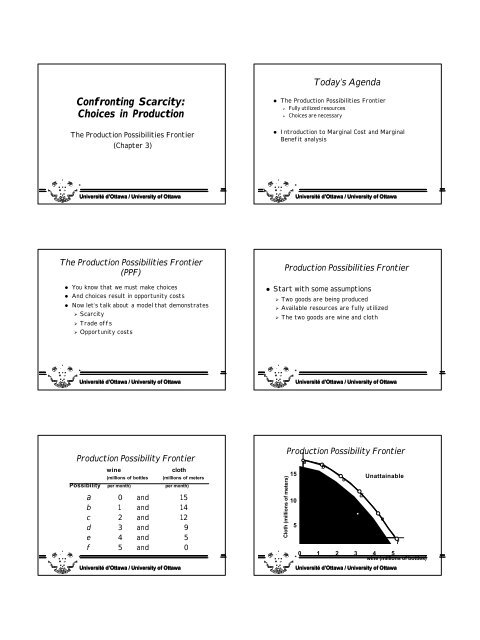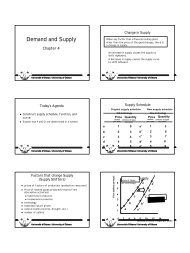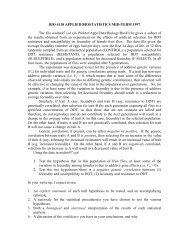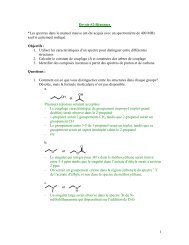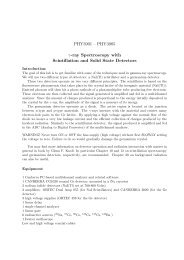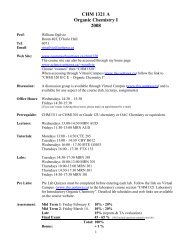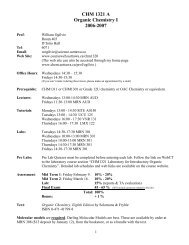(millions
6 per page - Université d'Ottawa
6 per page - Université d'Ottawa
- No tags were found...
Create successful ePaper yourself
Turn your PDF publications into a flip-book with our unique Google optimized e-Paper software.
Today’s Agenda<br />
Confronting Scarcity:<br />
Choices in Production<br />
The Production Possibilities Frontier<br />
(Chapter 3)<br />
• The Production Possibilities Frontier<br />
‣ Fully utilized resources<br />
‣ Choices are necessary<br />
• Introduction to Marginal Cost and Marginal<br />
Benefit analysis<br />
*<br />
Université d’Ottawa / University of Ottawa<br />
Université d’Ottawa / University of Ottawa<br />
*<br />
Université d’Ottawa / University of Ottawa<br />
Université d’Ottawa / University of Ottawa<br />
The Production Possibilities Frontier<br />
(PPF)<br />
• You know that we must make choices<br />
• And choices result in opportunity costs<br />
• Now let’s talk about a model that demonstrates<br />
‣ Scarcity<br />
‣ Trade offs<br />
‣ Opportunity costs<br />
Production Possibilities Frontier<br />
• Start with some assumptions<br />
‣ Two goods are being produced<br />
‣ Available resources are fully utilized<br />
‣ The two goods are wine and cloth<br />
*<br />
Université d’Ottawa / University of Ottawa<br />
Université d’Ottawa / University of Ottawa<br />
*<br />
Université d’Ottawa / University of Ottawa<br />
Université d’Ottawa / University of Ottawa<br />
Production Possibility Frontier<br />
*<br />
wine<br />
cloth<br />
(<strong>millions</strong> of bottles (<strong>millions</strong> of meters<br />
Possibility per month) per month)<br />
a 0 and 15<br />
b 1 and 14<br />
c 2 and 12<br />
d 3 and 9<br />
e 4 and 5<br />
f 5 and 0<br />
Université d’Ottawa / University of Ottawa<br />
Université d’Ottawa / University of Ottawa<br />
Cloth (<strong>millions</strong> of meters)<br />
Production Possibility Frontier<br />
15<br />
10<br />
5<br />
a<br />
b<br />
c<br />
Attainable<br />
z<br />
Unattainable<br />
0 1 2 3 4 5<br />
*<br />
wine (<strong>millions</strong> of bottles)<br />
Université d’Ottawa / University of Ottawa<br />
Université d’Ottawa / University of Ottawa<br />
d<br />
e<br />
f
Defining and calculating opportunity cost<br />
Production efficiency: cannot produce more of<br />
one good without producing less of some<br />
other good.<br />
When production is efficient, we are at a<br />
point on the PPF.<br />
‣ If we are at a point inside the PPF, we have unused<br />
resources, or misallocated resources, or both.<br />
Opportunity Costs<br />
On the PPF, every choice involves a tradeoff: to<br />
get something else means you must give up<br />
something else.<br />
All tradeoffs involve a cost<br />
‣ an opportunity cost.<br />
*<br />
Université d’Ottawa / University of Ottawa<br />
Université d’Ottawa / University of Ottawa<br />
*<br />
Université d’Ottawa / University of Ottawa<br />
Université d’Ottawa / University of Ottawa<br />
*<br />
Opportunity Costs<br />
The opportunity costof an action is the<br />
highest-valued alternative forgone.<br />
Movement along the PPF illustrates how much we must<br />
give up of one good to produce one more unit of<br />
another.<br />
Opportunity cost is a ratio: it is the decrease in the<br />
quantity produced of one good divided by the increase<br />
in the quantity of another good.<br />
Université d’Ottawa / University of Ottawa<br />
Université d’Ottawa / University of Ottawa<br />
Possibility<br />
Production Possibility Frontier<br />
a 0 15<br />
b 1 14<br />
c 2 12<br />
d 3 9<br />
e 4 5<br />
f 5 0<br />
*<br />
Wine<br />
(<strong>millions</strong> of<br />
bottles per<br />
month)<br />
Cloth<br />
(<strong>millions</strong> of<br />
meters per<br />
month)<br />
1/1 = 1<br />
2/1 = 2<br />
3/1 = 3<br />
4/1 = 4<br />
5/1 = 5<br />
Université d’Ottawa / University of Ottawa<br />
Université d’Ottawa / University of Ottawa<br />
Opportunity Cost<br />
Increasing Opportunity Costs<br />
• Notice that the opportunity costs went up<br />
• The PPF is bowed outward—which illustrates that<br />
opportunity costs rise.<br />
PPF and Opportunity Cost<br />
15<br />
10<br />
a<br />
b<br />
c<br />
d<br />
Increasing<br />
opportunity<br />
cost of wine<br />
Cloth (<strong>millions</strong> of meters per month)<br />
• Increase production of wine by one more unit—must<br />
reallocate some production resources from cloth to<br />
wine.<br />
5<br />
e<br />
• Opportunity costs tend to increase because not all<br />
resources are equally productive in all activities.<br />
*<br />
Université d’Ottawa / University of Ottawa<br />
Université d’Ottawa / University of Ottawa<br />
0 1 2 3 4 5<br />
wine (<strong>millions</strong> per month)<br />
*<br />
Université d’Ottawa / University of Ottawa<br />
Université d’Ottawa / University of Ottawa<br />
f
Four things to remember about PPF<br />
• Points inside are feasible, outside not feasible<br />
‣ Due to scarcity<br />
• PPF has a negative slope<br />
‣ Due to scarcity, illustrates trade-off<br />
• PPF has a concave shape<br />
‣ Resources are not equally well suited for the production of<br />
both goods (specialised capital, land, and labour)<br />
‣ Illustrates increasing opportunity costs<br />
• PPF can contract inward or expand outward<br />
‣ Caused by change in stock of resources and technology<br />
‣ Represents economic growth<br />
*<br />
Université d’Ottawa / University of Ottawa<br />
Université d’Ottawa / University of Ottawa<br />
concave shape<br />
*<br />
Université d’Ottawa / University of Ottawa<br />
Université d’Ottawa / University of Ottawa<br />
Opportunity Cost and Marginal Cost<br />
Marginal cost is the opportunity cost of<br />
producing one more unit of a good or service.<br />
• Marginal cost increases<br />
‣ the more we try to produce of any good, the less<br />
productive are the additional resources we devote<br />
to the production of that good.<br />
Increasing<br />
opportunity<br />
cost means<br />
increasing<br />
marginal<br />
cost of<br />
wine.<br />
Opportunity Cost and Marginal Cost<br />
Cloth (<strong>millions</strong> of meters)<br />
5<br />
4<br />
3<br />
2<br />
1<br />
MC<br />
*<br />
Université d’Ottawa / University of Ottawa<br />
Université d’Ottawa / University of Ottawa<br />
*<br />
0 1 2 3 4 5<br />
Wine (<strong>millions</strong> of bottles)<br />
Université d’Ottawa / University of Ottawa<br />
Université d’Ottawa / University of Ottawa<br />
*<br />
Marginal Benefit<br />
the benefit that a person receives from consuming<br />
one more unit of a good or service.<br />
The marginal benefit is measured as the maximum<br />
amount that a person is willing to pay for one more<br />
unit.<br />
The<br />
principle of decreasing marginal benefits<br />
is that the more we have of any one good<br />
or service, the smaller is our marginal<br />
benefit.<br />
Université d’Ottawa / University of Ottawa<br />
Université d’Ottawa / University of Ottawa<br />
a 0.5 5<br />
b 1.5 4<br />
c 2.5 3<br />
d 3.5 2<br />
e 4.5 1<br />
*<br />
Marginal Benefit<br />
Wine Willingness to Pay<br />
Possibility (<strong>millions</strong> of bottles) (meters per bottle)<br />
Université d’Ottawa / University of Ottawa<br />
Université d’Ottawa / University of Ottawa
Cloth (<strong>millions</strong> of meters per bottle)<br />
5<br />
4<br />
3<br />
2<br />
1<br />
a<br />
Marginal Benefit<br />
b<br />
c<br />
Decreasing<br />
marginal benefit<br />
from wine<br />
0 1 2 3 4 5<br />
*<br />
wine (<strong>millions</strong> of bottles)<br />
Université d’Ottawa / University of Ottawa<br />
Université d’Ottawa / University of Ottawa<br />
d<br />
e<br />
MB<br />
*<br />
Efficient use of resources<br />
Resource use is efficient when we produce the<br />
goods and services that we value most highly.<br />
• When resources are used efficiently<br />
‣ if we produce any more of one good, we give up<br />
something that we value even more highly<br />
‣ To find optimality decision, we compare the<br />
marginal cost to the marginal benefit.<br />
Université d’Ottawa / University of Ottawa<br />
Université d’Ottawa / University of Ottawa<br />
Efficient Use of Resources<br />
• If the marginal benefit of the last unit of a good<br />
exceeds its marginal cost, we increase production<br />
of that good.<br />
‣ MB > MC; increase<br />
• If the marginal cost of the last unit of a good<br />
exceeds its marginal benefit, we decrease<br />
production of that good.<br />
‣ MB < MC; decrease<br />
*<br />
Marginal cost and willingness to pay<br />
(meters of cloth per bottle)<br />
5<br />
4<br />
3<br />
2<br />
1<br />
Efficient Use of Resources<br />
Benefit<br />
exceeds<br />
cost<br />
Bottles of pop<br />
that people are<br />
willing to forgo<br />
Bottles of pop<br />
that people<br />
must forgo<br />
Cost<br />
exceeds<br />
benefit<br />
0 1.5 2.5 3.5 5<br />
*<br />
MB<br />
MC<br />
wine (<strong>millions</strong>)<br />
Université d’Ottawa / University of Ottawa<br />
Université d’Ottawa / University of Ottawa<br />
Université d’Ottawa / University of Ottawa<br />
Université d’Ottawa / University of Ottawa<br />
Specialization and trade expand<br />
production possibilities<br />
There are gains from trade<br />
Comparative advantage is the ability to perform<br />
an activity at a lower opportunity cost than<br />
anyone else.<br />
Comparative Advantage<br />
• Differences in comparative advantage give<br />
rise to gains in trade.<br />
• Suppose that CDs have two components: a<br />
disc and a plastic case.<br />
• Tom and Trish both own factories.<br />
‣ They can each produce both discs and cases, or<br />
they can specialize.<br />
‣ What should they do?<br />
*<br />
Université d’Ottawa / University of Ottawa<br />
Université d’Ottawa / University of Ottawa<br />
*<br />
Université d’Ottawa / University of Ottawa<br />
Université d’Ottawa / University of Ottawa
Comparative Advantage<br />
Tom’s Factory can<br />
‣ produce 4,000 discs/hour or<br />
‣ produce 1,333 cases/hour<br />
Opportunity Cost<br />
‣ To produce 1 case, he must decrease CD<br />
production by 3 discs — opportunity cost.<br />
‣ To produce 1 disc, he must decrease case<br />
production by 0.333 cases — opportunity cost.<br />
*<br />
Université d’Ottawa / University of Ottawa<br />
Université d’Ottawa / University of Ottawa<br />
Cases (thousands per hour)<br />
Production Possibilities in Tom’s<br />
5<br />
Factory<br />
4 Tom’s opportunity cost:<br />
1 disc costs 1/3 case,and 1 case costs 3 discs<br />
3<br />
2<br />
1<br />
*<br />
∆ Disks<br />
∆ Cases<br />
= opportunity cost of cases<br />
Tom’s PPF<br />
1 2 3 4<br />
Discs (thousands per hour)<br />
Université d’Ottawa / University of Ottawa<br />
Université d’Ottawa / University of Ottawa<br />
Trish’s Factory can<br />
Comparative Advantage<br />
‣ produce 1,333 discs/hour or<br />
‣ produce 4,000 cases/hour<br />
Opportunity Cost<br />
‣ To produce 1 case, she must decrease CD production<br />
by 0.333 discs — opportunity cost.<br />
‣ To produce 1 disc, she must decrease case production<br />
by 3 cases — opportunity cost.<br />
*<br />
Cases (thousands per hour)<br />
5<br />
4<br />
3<br />
2<br />
1<br />
b'<br />
Tom’s<br />
PPF<br />
*<br />
The Gains from Trade<br />
Tom’s opportunity costs:<br />
1 disc costs 1/3 cases,<br />
and 1 case costs 3 discs<br />
Trish’s<br />
PPF<br />
a<br />
c<br />
Trish’s opportunity costs:<br />
1 disc costs 3 cases,<br />
and 1 case costs 1/3 disc<br />
Trade line<br />
1 2 3 4<br />
Discs (thousands per hour)<br />
b<br />
Université d’Ottawa / University of Ottawa<br />
Université d’Ottawa / University of Ottawa<br />
Université d’Ottawa / University of Ottawa<br />
Université d’Ottawa / University of Ottawa<br />
Absolute Advantage<br />
An absolute advantage exists when a person or<br />
nation can produce more of a good than<br />
another with the same resources.<br />
Individuals and nations can have absolute<br />
advantages in any or all goods.<br />
However, it is not possible to have a<br />
comparative advantage in everything.<br />
*<br />
Université d’Ottawa / University of Ottawa<br />
Université d’Ottawa / University of Ottawa


